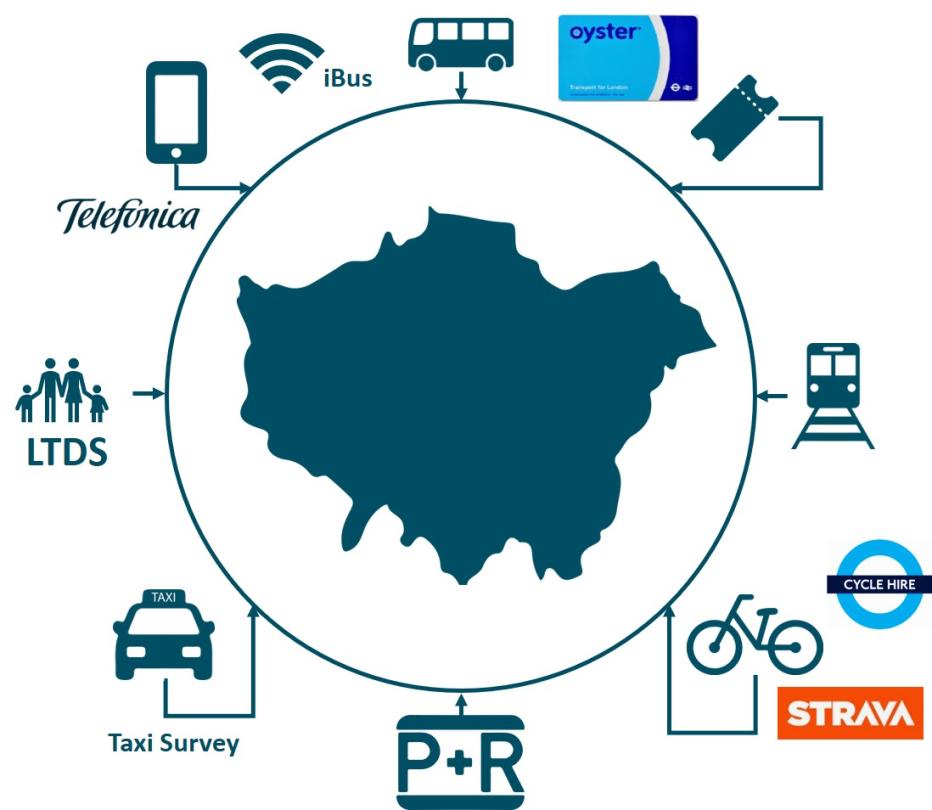
London is a dynamic city of 9 million people which has been planning and meeting the challenge of growth. The number of trips made in London in 2018 averaged 26.9 million per day, up more than 4 million since Transport for London (TfL) was founded in 2000. The COVID-19 pandemic has changed travel across the world and London is no exception, but in normal times a large proportion of these journeys is made by public transport. Overcrowding on some parts of the rail and Tube networks has a big impact on people’s quality of life, restricting access to jobs, education and training. With London’s population expected to reach 10.5 million by 2041 resulting in an additional 6 million daily trips, planning for better interconnected rail, bus, cycling and walking facilities is essential to unlocking this growth.
The Mayor’s Transport Strategy (MTS) 2018 sets out an ambitious plan to accommodate this growth sustainably and create an inclusive city for all Londoners and visitors. At its heart are three central themes: healthy streets and healthy people; a good public transport experience; and new homes and jobs. To achieve this ambition, the Mayor wants to encourage more people to walk, cycle and use public transport, with a vision for 80% of all journeys in London to be made by these modes by 2041.
-
10.5 M
Expected population in London by 2041
-
80 %
Goal of trips in London being made by sustainable modes by 2041
-
9 M
People in London (in 2018)
-
26.9 M
Average number of trips made per day in London in 2018
“The use of big data (and particularly mobile phone data) is the biggest technical step change in my 35 years in transport planning. The ability to collect a high sample of trip movements of all journeys, and then to infer key characteristics such as mode and journey purpose (as we did in Project EDMOND), and merge this dataset with other key data sources, has enabled us to develop a very robust trip matrix, as an input to MoTiON, which we have also enhanced to incorporate advanced modelling techniques. We have developed a tool which has brought new insights to transport planning in London and is enabling TfL to effectively plan for the ever-changing future.”
TfL has for decades used strategic models to support MTS and appraise new transport schemes and policies. TfL’s existing strategic models have been used to make the case for new investment such as the Piccadilly Line new trains and signaling, Crossrail 2, the Bakerloo Line Upgrade and Extension and Silvertown Tunnel. Strategic models not only provide the evidence for journey time savings in scheme appraisal, they are also used to aid the strategic narrative for the project and feed calculations of wider economic benefits such as agglomeration or increases in productivity into the business case. Strategic models can also be linked to land use models so that assessments can be made of the opportunities rail schemes provide for businesses to locate near each other and for homes to be built within easy access to jobs.
However, the new policy context alongside an ongoing change in consumer behaviors, lifestyles and travel habits of Londoners meant that TfL’s existing modeling and planning tools needed to be supplemented to plan for the future. Recent well documented phenomena include a rapid increase of mini cab usage stimulated by app-based services, reduced trip making, lower car ownership levels among the millennials and fast growth in cycling.
Ongoing technological advancement is likely to result in even more radical changes in the near future. This includes the emergence of ‘big data’ aided by ever more powerful computing and cloud storage, increased disruption in the transport market (e.g. Connected and Autonomous Vehicles - CAV, Mobility as a Service - MaaS) and ever-increasing uncertainty.
Given this overarching context (Figure 1), TfL needed a new forecasting toolkit based on the latest industry thinking and technological advances.
Figure 1: The context for new modeling and analytical techniques
A step change in TfL's ability to solve complex forecasting questions
To understand the key drivers of changing trends TfL first undertook research into the main factors influencing travel demand and published a report for Drivers of Demand in London explaining how travel had changed over the last decade. It then commissioned the development of a new analytical framework including the Model of Travel in London (MoTiON) to enhance forecasting and Project EDMOND to provide a comprehensive view of travel patterns in London. TfL appointed Jacobs to lead multi-consultancy teams working in partnership with TfL to deliver both projects. TfL also appointed John Bates to provide an independent expert advice on international best practice and the development of MoTiON.
Project EDMOND was the first large-scale big data project undertaken in a complex global city. Sub-consultant Telefónica UK provided anonymized and aggregated network data providing summaries of geographic travel patterns at zonal level (not at individual level). The data was used to update TfL’s models by fusing this anonymized and aggregated mobile network data with a diverse range of complementary datasets such as Oyster and the London Travel Demand Survey (LTDS). This helped achieve a step change in the quality of demand data used in modeling whilst providing a previously unattainable insight into anonymized zonal movements (journeys) on London’s transport network, far greater than has ever been available from traditional survey methods.

Figure 2: TfL’s models were updated by fusing anonymized and aggregated mobile network data with a diverse range of complementary datasets such as Oyster and the London Travel Demand Survey (LTDS)
MoTiON incorporates strategic assignment models and captures the intelligence from EDMOND data and predicts how personal travel in the capital may respond to changes in population and employment, new transport infrastructure and policy interventions. It offers a complete refresh of travel behaviour building on TfL’s Drivers of Demand studies and provides insights into behavioral change by various population groups for all main modes of transport. A ground-breaking approach using a population synthesizer helps to imitate the impact of changing demographic make-up of London in potential future scenarios. This could help to plan for an ageing population, with increasing accessibility needs or to reflect the positive impact of regeneration.
The representation of the propensity to cycle will allow TfL to understand how removing behavioral barriers could unlock more journeys by bike and support better connectivity by public transport. The ability to represent future modes such as MaaS and CAV will allow TfL to assess the possible impact of structural changes to the transport system. Rather than their arrival being unplanned, TfL can use MoTiON to test the impact of such new modes and plan for a future where they complement rather than disrupt one of the world’s most admired transport systems.
Supporting MoTiON is a set of a high-quality visualization tools to aid result interpretation and stakeholder engagement, with an example provided in Figure 3.

Figure 3: Current (Pre-COVID-19) Rail Demand in London
Dealing with uncertainty
MoTioN was designed to look at the behavioral, technological and economic elements of uncertainty through scenario planning. In light of the pandemic this has become more important than ever and modeling is being used to explore possible futures for London. The new analytical framework is also playing a significant role in shorter term COVID-19 analysis. The model uses synthesized population to represent realistic behavior and travel preferences depending on a person’s job, age, gender and access to car. The insights are helping to solve major logistical challenges, inform traffic management measures, introduce additional cycle and walking facilities and tailor the capacity to meet the needs of key workers.
London is leading the way in planning for and delivering a green recovery. MoTiON allows TfL to test and promote policies and assess their effectiveness in achieving the MTS sustainable transport mode share targets. As the new tool has such a solid base in aggregated, anonymized mobile phone data, the LTDS and statistical modeling of the drivers of transport choice (i.e. whether to travel, where to travel, which mode to take, which route to take), it can forecast changes more accurately. MoTiON also has far more policy ‘levers’ than previous strategic models of London allowing TfL to test a wide range of interventions. Fundamentally MoTiON is a more useful tool for addressing the complex challenges facing transport planners.
MoTiON will take the place of the London Transportation Studies (LTS) Model, TfL’s previous demand model, and will enhance strategic studies. Compared to previous assessments the scheme demand response will take advantage of MoTiON’s detailed segmentation capabilities and its integration with TfL’s other strategic tools. TfL can also use MoTiON to assess the scheme in different future scenarios to increase confidence in the robustness of a scheme in an uncertain future. Scenario planning will play an increasing role in appraisal and the new tools provide a step change in TfL’s ability to solve complex forecasting questions.
MoTiON’s strength in explaining nuanced travel choices made by various population groups will be instrumental in representing realistic behavior and will enable social value analysis and the prioritization of schemes based on their impact on wellbeing and equality.
“MoTiON is a new state of the art strategic transport forecasting tool which has transformed TfL’s forecasting capability. It was developed to reflect London’s changing drivers of travel demand and to enable TfL to better understand the impacts of future economic and behavioral uncertainty. It is being used to test schemes, strategies and policies to help TfL achieve the Mayor’s goal of 80% of trips in London being made by sustainable modes and to understand the potential impacts of the COVID-19 pandemic on travel demand. In conjunction with TfL’s well established scenario planning approach, it puts TfL in a position to make informed decisions on how to plan the future of London in uncertain times based on the best possible evidence.”












































